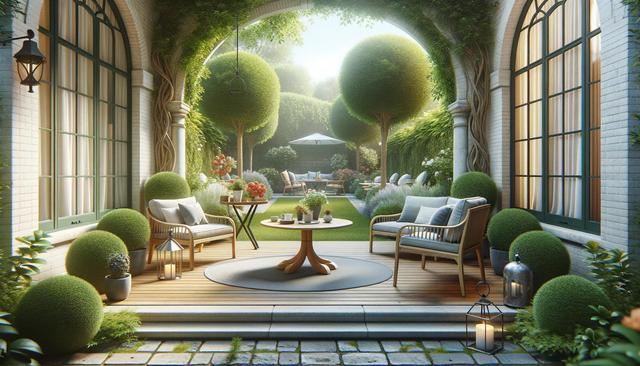Understanding the Role of Garden Furniture
Garden furniture is more than just a decorative element—it’s an extension of your home’s living space. Whether you have a sprawling backyard, a modest patio, or a cozy balcony, the right furniture can significantly enhance the way you experience the outdoors. By choosing suitable seating and tables, you create an inviting environment where relaxation, dining, and socializing come naturally. This functional aspect, coupled with aesthetic appeal, makes thoughtful furniture selection essential for outdoor areas.
Modern garden furniture pieces are designed not only for comfort but also to withstand different weather conditions. Materials such as treated wood, powder-coated metals, and synthetic rattan are commonly used for their durability and low maintenance. Additionally, many outdoor furniture designs now prioritize sustainability, using recycled or responsibly sourced materials to cater to environmentally conscious homeowners.
Key Materials and Their Benefits
When selecting garden furniture, understanding the pros and cons of various materials helps in making informed decisions. Each material offers unique advantages in terms of durability, appearance, and upkeep. Here are some common options:
- Wood: Offers natural beauty and warmth. Teak and acacia are popular choices due to their weather-resistant qualities.
- Metal: Aluminum and stainless steel are lightweight and rust-resistant, ideal for modern aesthetics.
- Rattan and Wicker: Synthetic versions are UV-resistant and suitable for various climates.
- Plastic: Affordable and lightweight, available in diverse styles and colors.
Choosing the right material also depends on how much maintenance you are willing to commit to. For instance, wooden furniture might require regular oiling or sealing, while metal pieces may need occasional cleaning to prevent corrosion. Consider your lifestyle, local climate, and usage frequency when evaluating these options.
Designing for Comfort and Functionality
Comfort should never be compromised when it comes to outdoor seating. Ergonomic designs, appropriate cushioning, and ample support contribute significantly to the usability of garden furniture. It’s worth investing in high-quality cushions made from weather-resistant fabrics that resist fading and mold. Beyond comfort, functionality is equally important. Multi-use furniture, such as benches with storage or modular seating sets, can enhance utility without overcrowding your space.
Here are a few elements to consider for maximizing comfort and utility:
- Adjustable reclining chairs for sunbathing or reading
- Foldable tables and chairs for easy storage during off-seasons
- Ottomans and footrests for added relaxation
- Side tables to hold drinks, books, or decorative items
Ensuring your garden furniture layout allows for easy movement and accessibility also adds to the overall experience. A well-thought-out arrangement fosters conversation and flow, making outdoor gatherings more enjoyable.
Creating Ambiance with Accessories
Accessories play a vital role in completing the look and feel of your outdoor setup. Items such as outdoor rugs, throw pillows, lighting, and planters help personalize the space while enhancing comfort. These additions can introduce color, texture, and warmth to an otherwise plain patio or lawn. Lighting options like solar-powered lanterns, fairy lights, or LED candles can transform the mood from day to night effortlessly.
Weather protection is another important factor. Consider adding:
- Retractable awnings or pergolas for shade
- Outdoor umbrellas to shield from direct sunlight
- Furniture covers to protect against rain and dust
Even small details, like a centerpiece on your outdoor dining table or a cozy blanket for cooler evenings, can make a big difference. These elements not only improve aesthetics but also ensure that your outdoor space remains inviting throughout different seasons.
Maintenance and Seasonal Storage Tips
Proper care ensures that your garden furniture remains in good condition for years. Maintenance needs vary depending on the material, but a few general practices can help extend the life of your furniture. Regular cleaning to remove dirt, pollen, and mildew is essential. For wooden items, occasional sanding and oiling may be required, while metal surfaces might need rust treatment if exposed to moisture over time.
Seasonal storage is also critical, especially in areas with harsh winters. Lightweight or foldable furniture should be stored indoors or in a shed when not in use. For heavier pieces, using weather-resistant covers can provide sufficient protection. Here are a few seasonal care tips:
- Clean and dry furniture thoroughly before storing
- Disassemble modular pieces to save space
- Cover with breathable fabric to prevent mold and condensation
Investing in storage solutions such as deck boxes or waterproof cabinetry can also help keep cushions and accessories organized and protected. Taking these simple steps ensures your outdoor setup is always ready for the next season of use.
Conclusion: Enhancing Outdoor Living Through Smart Furniture Choices
Garden furniture is a central component of any outdoor living space, influencing both its usability and ambiance. By carefully selecting materials, prioritizing comfort and functionality, and incorporating thoughtful design elements, homeowners can create a versatile and inviting area that reflects their lifestyle. Whether for quiet moments alone or entertaining guests, well-maintained and stylish garden furniture enhances the enjoyment of outdoor spaces throughout the year. With a bit of planning and care, your garden can become a true extension of your home.


